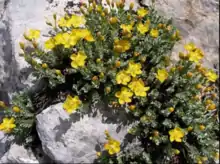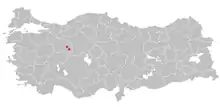Hypericum sechmenii
Hypericum sechmenii, commonly called seçmen kantaronu in Turkish[2] which means Seçmen's St. John's wort in English, is a rare species of flowering plant of the St. John's Wort family (Hypericaceae) endemic to Eskişehir province in central Turkey. It was described by Turkish botanists Atila Ocak and Onur Koyuncu who named the species in honor of Özcan Seçmen, a fellow Turkish botanist. Found in the crevices of limestone outcroppings, it is a perennial herb which grows in clusters of stems from 3–6 centimetres (1.2–2.4 inches) tall. The species was first collected in 2006 and has since been observed in only two localities with an estimated population of less than 250.
| Hypericum sechmenii | |
|---|---|
 | |
| Scientific classification | |
| Kingdom: | Plantae |
| Clade: | Tracheophytes |
| Clade: | Angiosperms |
| Clade: | Eudicots |
| Clade: | Rosids |
| Order: | Malpighiales |
| Family: | Hypericaceae |
| Genus: | Hypericum |
| Section: | Hypericum sect. Adenosepalum |
| Species: | H. sechmenii |
| Binomial name | |
| Hypericum sechmenii Ocak & O.Koyuncu | |
 | |
| Approximate distribution of Hypericum sechmenii[1]:4 | |
Description
Hypericum sechmenii is a flowering perennial herb that grows in dense clusters of upright stems. The outside of its roots has a very thick waterproof protective covering made of fats and wax called a cuticle. Directly beneath the cuticle lies one to two bark-like layers of periderm which are composed of several layers of dead cells. Beneath the periderm there are several layers of thin-walled tissue cells called a cortex. The tissue of the roots is completely covered in elements of water transport tissue called xylem.[1]:8
The numerous smooth and hairless stems of Hypericum sechmenii are typically 3–6 cm (1.2–2.4 in) tall.[3] The first layer of plant cells between the environment and the inside of the stem is a thin cuticle which covers a single-layer epidermis. Beneath this epidermis, there are several layers of oval peridermal cells that contain suberin, a waxy substance that helps to waterproof the stems. Some cells in the periderm also have inorganic minerals inside of them known as druse crystals. These druse crystals are thought to deter herbivory because of their toxicity.[1]:7
The leaves of Hypericum sechmenii are sessile (with no leafstalks) and attach directly to the stems. They are roughly 2–5 millimetres (0.079–0.197 inches) long,[4][5]:592 and they densely overlap each other. The texture of the leaves is described as somewhat leathery. They are either egg-like (ovate) with a broader base or elliptic in shape, with rounded tips and pointed bases. There are numerous pale glands on the surfaces of the leaves, and a few black glands can be found on the margins (edges).[5]:592 On both sides, there are stomata pores, and there is tightly packed palisade tissue which consists of leaf cells just below the epidermis. The palisade tissue performs the greatest amount of photosynthesis. The hypodermal cells directly beneath the epidermis have druse crystals, and the central vein of the leaf is distinctly larger and more prominent than the lateral veins, giving the leaves a distinct midrib.[1]:4–5
Inflorescences (flower clusters) grow on the ends of the stems and will typically have three to five flowers in corymbs. The corymbs of Hypericum sechmenii have longer pedicels on the outer flowers than on the inner ones, leading to the cluster having a level top. The specialized bract leaves which surround the flowers are long and have both glands and small hairs. The sepals are roughly 2 mm (0.079 in) long, oblong, and can be either pointed or rounded. Their edges also have glands and small hairs, similar to the bracts. However, they may have a few black or amber dots and amber colored lines which the bracts do not. The petals are 4–7 mm (0.16–0.28 in) long and have amber glands that can take the shape of dots or short lines. On the edges of the petals there are a few black glands.[4][5]:592 The pollen grains of Hypericum sechmenii have three grooves in a triangular layout, with the overall shape of the grain a slightly elongated sphere.[5]:592
The seed capsules are 3–4 mm (0.12–0.16 in) long and oval in shape, and their ovaries have a few oil cavities which run lengthwise along the capsule. The seeds themselves have tiny, regular pits in the shape of small lines or ladders.[5]:592

Taxonomy
In 1977, British taxonomist Norman Robson began a genus-wide monograph of Hypericum which divided the genus into 36 sections, with almost every species in the genus being placed into one of these sections based on their morphology and phylogeny. However, Hypericum sechmenii was omitted from this original monograph, as it had not yet been identified as a unique species.[6]:1,4
The holotype of the species was first collected in 2006 at Günyüzü by Atila Ocak and is now housed at Eskişehir Osmangazi University,[4] but the species was not formally described until almost three years later in December of 2009 in the 46th volume of the peer-reviewed journal Annales Botanici Fennici. Hypericum sechmenii was described by Atila Ocak and Onur Koyuncu alongside Filiz Savaroglu and Ismuhan Potoglu, the four of whom are all Turkish botanists.[7] Ocak and Koyuncu gave the species the specific epithet sechmenii as an homage to the prominent Turkish taxonomist and ecologist Özcan Seçmen, and in Turkey the plant is known as seçmen kantaronu, translated as Seçmen's St. John's wort.[2][5]:592
After Hypericum sechmenii was described, it was then placed into the overall framework of the genus Hypericum by Robson in a 1996 addition to his monograph. Robson corroborated the findings of Ocak and Koyuncu that H. sechmenii was its own species, taking note of its similarities to other Anatolian species of Hypericum, specifically Hypericum minutum and Hypericum huber-morathii. Because of this, Robson placed the species in a clade called the Huber-morathii Group which comprises five Turkish species of Hypericum and lies within the large section Adenosepalum.[3]
Distribution and habitat
Hypericum sechmenii is one of numerous species of Hypericum which are endemic to Turkey. Specifically, the species is endemic to central Turkey in northwestern Anatolia, in Eskişehir province.[2][8] The species is known only from two separate localities, one near the peak of Arayit Mountain and one between the towns of Kaymaz and Sivrihisar. The species' habitat is usually in and among the crevices of limestone rocks and outcroppings. The holotype of the species was collected at an elevations about 1,800 metres (5,900 feet), and the general range of elevation of the species is 1,750–1,820 m (5,740–5,970 ft).[5]:591-592[4]
| Type | District | Locality | Habitat | Coordinates | Collection Date | Herbarium | Reference |
|---|---|---|---|---|---|---|---|
| Holotype | Günyüzü | Arayit Mountain | Rock crevices | 39°18.243'N, 31°44.851'E | 10 June 2006 | Eskişehir Osmangazi University | [5] |
| Isotype | Günyüzü | Arayit Mountain | Rock crevices | 39°18.243'N, 31°44.851'E | 10 June 2006 | Gazi University | [7] |
| Isotype | Günyüzü | Arayit Mountain | Rock crevices | 39°18.243'N, 31°44.851'E | 10 June 2006 | Hacettepe University | [7] |
| Sivrihisar | Arayit Mountain | Hilly steppe | 39°17′47.3″N, 31°45′07.3″E | 7 July 2011 | [1] | ||
| Sivrihisar | Sivrihisar-Kaymaz | Kaymaz rocks | 31°13′56″N, 39°32′19.5″E | 13 July 2011 | [1] |
Ecology
Hypericum sechmenii usually flowers in either June or July, and it fruits in July.[5]:592
Hypericum sechmenii is found in and among a number of other plant species. Specifically, it grows alongside small shrubs and perennial herbs like Aethionema subulatum, Asperula nitida, Asyneuma compactum, Chaenorhinium minus, Hesperis kotschyi, Linum cariense, Ononis adenotricha, Scorzonera tomentosa, Silene falcata, and Stachys lavandulifolia. It is found among only one other Hypericum species, which is Hypericum confertum.[5]:593
Conservation
It is estimated that there are fewer than 250 members of the species that inhabit an area which is approximately 10 square kilometres (3.8 square miles). The species is under threat from both abiotic factors, especially climate change, and human impact from agriculture and grazing. Because of these threats and the species' unhealthy population, it has been recommended by biologist Koray Yaylaci that the species be classified as Critically Endangered by the International Union for Conservation of Nature (IUCN).[1]:8–9
References
- Yaylaci, Ömer; Özgisi, Kurtulus; Sezer, Okan; Orhanoğlu, Gökhan; Öztürk, Derviş; Koyuncu, Onur (2013). "Anatomical studies and conservation status of rare endemic Hypericum sechmenii Ocak&Koyuncu (Sect: Adenosepalum) from Eskişehir - Turkey". Journal of Selçuk University Natural and Applied Science. 2 (1): 1–11. Retrieved 5 February 2021 – via ResearchGate.
- Güner, A.; Aslan, S.; Ekim, T.; Vural, M.; Babaç, M.T. (2013). "Turkish Plants List (Vascular Plants)". www.bizimbitkiler.org.tr (in Turkish). Nezahat Gökyiğit Botanical Garden. Retrieved 4 February 2021.
- Robson, Norman K.B. (31 October 1996). "Studies in the genus Hypericum L. (Guttiferae) 6. Sections 20. Myriandra to 28. Elodes". Bulletin of the Natural History Museum, Botany Series. 26 (2): 75–217. ISSN 1475-2956 – via Biodiversity Heritage Library.
- Pattinson, David; Robson, Norman; Nürk, Nicolai; Crockett, Sarah. "Hypericum sechmenii Nomenclature". Hypericum Online (hypericum.myspecies.info). Retrieved 5 February 2021.
- Ocak, Atila; Savaroglu, Filiz; Potoğlu Erkara, İsmuhan; Koyuncu, Onur (2009). "Hypericum sechmenii (Hypericaceae), a new species from Central Anatolia, Turkey" (PDF). Annales Botanici Fennici. 46 (6): 591–594. doi:10.5735/085.046.0616. ISSN 0003-3847. S2CID 86751774. Retrieved 5 February 2021 – via www.sekj.org.
- Carine, Mark A.; Christenhusz, Maarten J.M. (14 May 2013). "About this volume: the monograph of Hypericum by Norman Robson". Phytotaxa. 4 (1): 1–4. doi:10.11646/phytotaxa.4.1.1. ISSN 1179-3163.
- International Plant Names Index (IPNI) (2020). "Hypericum sechmenii Ocak & O.Koyuncu, Ann. Bot. Fenn. 46(6): 591 (-594; figs. ) (2009)". IPNI (www.ipni.org). The Royal Botanic Gardens, Kew; Harvard University Herbaria & Libraries; and, Australian National Botanic Gardens. Retrieved 5 February 2021.
- POWO (2019). "Hypericum sechmenii Ocak & Koyuncu". Plants of the World Online (powo.science.kew.org). Royal Botanic Gardens, Kew. Retrieved 5 February 2021.